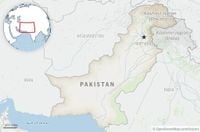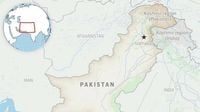In a dramatic escalation of Pakistan’s ongoing battle against militancy, security forces launched a series of targeted raids on three militant hideouts near the country’s volatile northwestern border with Afghanistan, killing 19 fighters over two days. The military operations, carried out on September 10 and 11, 2025, underscore both the scale of the threat posed by insurgent groups and the Pakistani government’s determination to confront them head-on.
The largest of the operations unfolded in Mohmand district, a rugged region in Khyber Pakhtunkhwa province that has long been a flashpoint for cross-border violence. According to statements released by the Pakistani military and reported by both the Associated Press and Khaama Press, fourteen militants were killed in Mohmand on September 10. The very next day, coordinated raids in North Waziristan and Bannu districts resulted in the deaths of five more fighters.
The military described the militants as "Khwarij," a term Islamabad frequently uses to refer to members of the Tehreek-e-Taliban Pakistan (TTP), also known as the Pakistani Taliban. This group, while allied with the Afghan Taliban, is organizationally distinct and has been responsible for a string of deadly attacks across Pakistan in recent years. The Pakistani Taliban’s campaign of violence has been particularly pronounced since the Afghan Taliban’s return to power in Kabul in 2021, a development that has reshaped the security calculus across the region.
Last week, the Pakistani Taliban demonstrated their lethal capabilities in a brazen assault on a security camp in Bannu, also located in Khyber Pakhtunkhwa. That attack, which took place on September 2, left six Pakistani soldiers dead and reignited concerns about the group’s operational reach. The military’s latest raids were launched just days after this incident, a timeline that suggests a direct response to the mounting threat posed by the TTP.
Defense Minister Khawaja Asif provided further details on the Bannu assault, stating that five attackers were killed during the firefight, including three Afghan nationals. This revelation, reported by Khaama Press, highlights the increasingly cross-border nature of the insurgency and the challenges faced by Pakistani authorities in stemming the flow of militants and weapons across the porous frontier. Islamabad has repeatedly accused both the Afghan Taliban and India of backing the TTP since 2021, though both parties have consistently denied these allegations.
The death of Maj. Adnan Aslam, who succumbed to his wounds on September 10 after being critically injured in the Bannu attack, has become a rallying point for the nation. Video footage circulating online shows Aslam heroically shielding a wounded comrade during the assault before returning fire and killing an attacker, even as he was gravely wounded himself. The outpouring of grief and respect was palpable, with Prime Minister Shehbaz Sharif and army chief Field Marshal Asim Munir attending Aslam’s funeral during the week of September 8–12. Aslam has been widely hailed as a hero, emblematic of the sacrifices made by Pakistani security personnel in the fight against extremism.
Pakistan’s military operations over the past week must be viewed within the broader context of a surge in militant attacks that has swept the country, particularly in its northwestern and southwestern regions. According to both AP and Khaama Press, much of the violence has been attributed to the Pakistani Taliban and Baloch separatists. The latter group has waged its own insurgency in Balochistan, the country’s largest and least developed province, further stretching the resources of Pakistan’s security apparatus.
For many Pakistanis, the renewed violence is a grim reminder of earlier years when militant attacks were a near-daily occurrence. The TTP, formed in 2007, has carried out some of the deadliest attacks in Pakistan’s history, including the 2014 massacre at a school in Peshawar that left more than 140 people dead, most of them children. While military operations in recent years had pushed the group into retreat, its resurgence since 2021 has raised alarm bells in Islamabad and beyond.
Pakistan’s accusations against the Afghan Taliban and India reflect the complexity of the regional security landscape. Since the Taliban’s return to power in Kabul, Islamabad has argued that safe havens for the TTP have proliferated across the border, enabling the group to launch attacks with impunity. The Afghan Taliban, for its part, has insisted that it does not allow foreign militants to operate from Afghan soil, while India has dismissed Pakistani claims as baseless. The truth, as is often the case in this part of the world, is difficult to pin down—especially as all sides seek to advance their own strategic interests.
The operations in Mohmand, North Waziristan, and Bannu are a stark illustration of Pakistan’s struggle to contain escalating militancy along its western frontier. The military’s willingness to launch high-casualty raids so soon after the loss of six soldiers in Bannu suggests a new sense of urgency. Yet, as the cycle of violence and reprisal continues, many observers fear that the underlying drivers of militancy—poverty, political disenfranchisement, and regional rivalries—remain unaddressed.
For the families of the soldiers killed in recent weeks, and for millions of ordinary Pakistanis living in the shadow of violence, the stakes could hardly be higher. Each new attack, each funeral attended by the nation’s leaders, serves as a sobering reminder that the fight against extremism is far from over.
As Pakistan’s security forces continue their operations, the world watches closely, aware that the outcome will shape not only the country’s future but the stability of an entire region. For now, the battle lines remain drawn, and the sacrifices of those on the front lines—like Maj. Adnan Aslam—are etched into the national consciousness.


